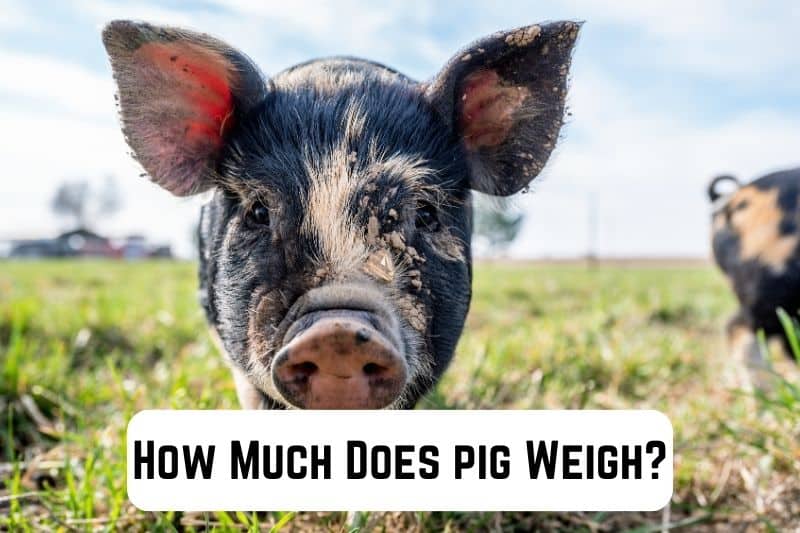Have you ever wondered how much a pig weighs? This is a helpful topic for those interested in farming, animal biology, or just general knowledge. Pigs come in various sizes and breeds, so their weights can vary greatly. In this article, we will discuss some common ranges and factors that contribute to a pig’s weight.
To better understand a pig’s weight, it’s important to remember that genetics, diet, and environment influence their growth and development. As you read on, you’ll learn about the average weights of different pig breeds and how these weights change as they mature.
Knowing a pig’s weight is crucial not only for farmers who raise them but also for anyone interested in animal welfare or food production. In the following sections, we’ll dive deeper into the factors that impact pig weight as well as some reliable methods for weighing them.
Read: How Much Does Deer Weigh? (Detailed Guide)
Market Pigs are raised for meat production and typically weigh around 240-280 pounds. Adult male pigs (boars) usually weigh between 500-900 pounds while adult female pigs (sows) can weigh from 400-700 pounds. Mini pigs typically weigh between 100-200 pounds when fully grown.
Pig Classification and Their Weight Ranges
Generally, pigs can be classified into three categories: market pigs, breeding pigs, and mini pigs or pet pigs.
Market Pigs
Market Pigs are raised for meat production, and they are typically slaughtered when they weigh around 240-280 pounds. They reach this weight at about 6 to 7 months old. Examples of these breeds include Yorkshire, Duroc, and Hampshire.

Breeding Pigs
Breeding Pigs are used for reproduction and they are heavier than market pigs. Adult male pigs (boars) usually weigh between 500-900 pounds while adult female pigs (sows) can weigh from 400-700 pounds. Common breeds used for breeding include Large White, Landrace, and Pietrain.

Mini Pigs or Pet Pigs
Mini Pigs or Pet Pigs have become popular household pets due to their smaller size, intelligence, and affectionate nature. Mini pigs typically weigh between 100-200 pounds when fully grown, which they reach around 2-3 years of age. Some popular mini pig breeds are the Juliana, Potbelly, and Miniature Kunekune.

Factors Affecting a Pig’s Weight
When considering how much a pig weighs, several factors come into play. In this section, we will discuss the primary factors affecting a pig’s weight such as breed, age, sex, and health.
Breed
Different pig breeds typically have different weights. For example, commercial breeds like Duroc and Yorkshire usually weigh more than heritage breeds such as Tamworth or Gloucestershire Old Spot.
Below are the average weights for the mentioned breeds. Other popular breeds will be discussed further in the following section.
- Durocs can reach weights of 600-800 pounds
- Yorkshires generally weigh between 500-700 pounds
- Tamworth pigs often weigh around 500 pounds
- Gloucestershire Old Spots usually weigh about 600 pounds
Age
Pigs grow rapidly, especially during their first year of life. As they grow older, they will reach a more stable adult weight. Here’s a general idea of how a pig’s weight changes with age:
- Newborn piglets typically weigh 2-4 pounds
- At three months, they can weigh around 40-60 pounds
- Six-month-old pigs may weigh 150-200 pounds
- By nine months, their weight can range between 200-300 pounds
- At one year old, pigs can weigh 300-600 pounds, depending on the breed and other factors
This will be discussed in detail in a separate section.
Sex
There can be slight differences in weight between male and female pigs. Generally, males (boars) are heavier than females (sows) due to their larger, more muscular frames. Boars can weigh 10-20% more than sows of the same age and breed.
Remember that these differences are not always noticeable and can vary depending on other factors, such as the pig’s overall health and nutrition.
Health
Just like with humans, a pig’s weight can be influenced by its health. Pigs that are properly fed and cared for will reach their optimal weight more quickly than those that are malnourished or experiencing health issues.
- Healthy, well-fed pigs have an excellent weight-to-height ratio and visible muscle tone.
- Ill or malnourished pigs may be underweight, with low energy levels and a weak appearance.
By considering these factors, you can better understand how much a pig might weigh and what influences their overall weight.
Understanding Pig Breeds and Their Average Weights
Regarding pig breeds, there is quite a bit of variety in size and weight. In this section, we will focus on three popular breeds: Large White, Duroc, and Berkshire.
Large White
The Large White, also known as the Yorkshire pig, is a popular breed due to its impressive size and high meat quality. This breed is known for its strong, sturdy frame and white color. The average weight of a Large White pig can vary depending on factors such as age and diet, but typically falls within the following ranges:
- Males (boars): 750-850 lbs (340-385 kg)
- Females (sows): 600-700 lbs (270-315 kg)
Duroc
Durocs are known for their distinct red color and solid build. Often praised for their good meat quality and rapid growth rate, Durocs are popular among both farmers and consumers. On average, the weight of Duroc pigs lies within these ranges:
- Males (boars): 750-800 lbs (340-360 kg)
- Females (sows): 500-600 lbs (225-270 kg)
Berkshire
Berkshire pigs are another popular breed, recognized for their black color with white points and high-quality meat. They have a medium size compared to the other breeds mentioned here. The average weight for a Berkshire pig can be found within these ranges:
- Males (boars): 600-700 lbs (270-315 kg)
- Females (sows): 400-500 lbs (180-225 kg)
Take note that the abovementioned weight ranges are just there to serve as a benchmark and the actual weights of individual pigs may differ from these averages.
Weight According to Age
When raising a pig, it’s essential to understand how their weight changes as they age. This knowledge will help you in managing their nutrition and ensuring their well-being.
In general, pigs multiply, especially during the first few months. However, the weight may vary depending on factors like the pig’s breed, diet, and environment.
During the first month, the average piglet weighs around 12-15 pounds. This period is crucial for their development, as they rely on their mother’s milk for sustenance. Make sure to provide them with a safe and warm environment to ensure healthy growth.
As your pig enters the second month, its weight will likely increase significantly. At this point, you can expect the pig to weigh between 40-50 pounds. Gradually introduce solid foods during this period to supplement their diet and promote healthy weight gain.
Between 3 and 6 months, the pig’s weight will continue to grow, but the pace may slow down a bit. At this stage, they should weigh anywhere from 100-180 pounds. Focus on providing a well-balanced diet of essential nutrients to support their growth.
Here’s a summary of the average pig weights according to age:
- 1 month: 12-15 pounds
- 2 months: 40-50 pounds
- 3-6 months: 100-180 pounds
Bear in mind that these figures are just general estimates and your pig’s actual weight may vary. Regularly monitoring your pig’s weight and adjusting their diet and exercise routine accordingly will ensure they grow at a healthy pace.
Read: How Much Does a Chicken Weigh? Quick Guide for Poultry Enthusiasts
Weight and Pig’s Market Value
When you raise pigs, their weight is crucial in determining their market value. Usually, a pig is ready for market when its weight falls between 100 and 250 pounds.
One major factor in determining the ideal weight and amount they can be sold for is the purpose of raising pigs. If you’re raising pigs for lean meat, the ideal marketable weight is 220-250 pounds.
However, aiming for a heavier pig is more appropriate for fatty cuts or specific meat markets (charcuterie, for example). Be sure to research the preferences of your target market before deciding on the ideal weight you should raise your pigs to.
Considering these factors, you can maximize your pigs’ weight gain, allowing you to sell them at a competitive market value.
Summary
Several factors come into play when you’re trying to determine how much a pig weighs. These include the pig’s age, breed, and purpose (whether it’s raised for meat or as a pet). Generally, pigs can weigh anywhere from a few pounds to over 1,000 pounds.
It is important to note that pigs are social animals and grow at different rates. Aside from breed, some factors that can affect a pig’s growth rate are diet, health, and living conditions. Providing the appropriate environment and nutrition can greatly influence a pig’s weight. Remember, a happy and healthy pig will thrive under your care!







